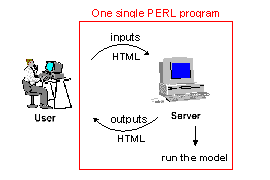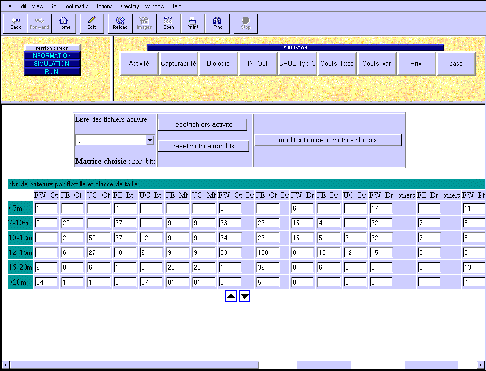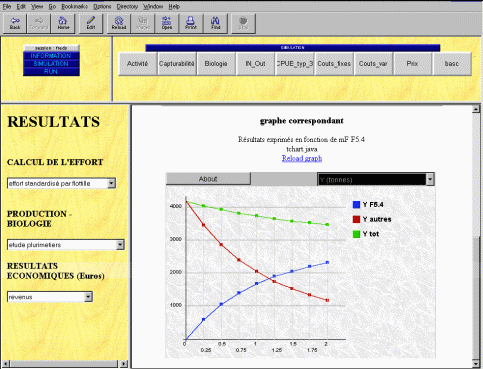Volume 13, Issue 2, 1999
The use of the Internet for scientific modelling purposes : Interest, implementation and example of application.
- Clara Ulrich and Jérôme Guitton
- Laboratoire Halieutique, ENSAR, France
Introduction
In recent years the development of computer capacities has brought a new aspect to scientific research : modelling and simulation. Computers allow scientists to build large mathematical models, and to test the relevance of their hypothesis.
In the modelling process three types of constraints are inherent to the use and the spread of the model to be built. A good calculation speed, an easy way to display and analyse the results, and a means of diffusion of the model to other people who may be interested.
Some powerful modelling software has been developed by computer experts, in order to fit the needs of as many users as possible. But they may not be well adapted for specific needs, either too slow to calculate if the model is rather complex and involves a great number of parameters, or without specific mathematical functions likely to be used. The solution is then to program oneself the model, through the use of a programming language. Depending on the computer powerfulness, a good calculation speed can be obtained, but the two other constraints are not always satisfied. Results may be displayed with any kind of graphical or mapping software (such as spreadsheet or GIS), which have then to be linked to the programming interface. And finally, because of many different computer configurations, a large-scale diffusion of the model is not always possible. For instance, there is almost no software that may be compatible with all Windows, Unix and Mac operating systems.
The purpose of this paper is then to present a new modelling methodology. The three constraints already mentioned are fully filled by crossing a programming language, for the calculation speed and the total flexibility of the modelling process, and an Internet interface, for the user-friendliness and the greatest diffusion of the model. The principle and the interests are firstly detailed, then an example application is presented.
Recent trends in the use of the Internet
First uses of the Internet deal with a simple displaying of information. By clicking on various kinds of buttons, the user can get directly the required information, i.e. all texts, graphs, pictures implemented on line by the webmaster. There is no return from the user, who is just a reader.
The second range of websites uses the Internet as an interactive interface between a user and a provider. By filling and submitting forms, directly on the interface, the user is able to ask for specific questions, to get registered, to chat and/or to buy and pay for merchant or non merchant goods.
A third range of application, more recent than the two others sub-cited, uses the Internet as a real scientific tool, not only for information and communication, but also as integrated software. This means that the Internet interface is thoroughly linked with other computer applications such as mathematical programs, graphical software. It is even more the cornerstone of the whole software, for that it is the only link between the user and the software, and also among the various applications of the software.
The method we present now belongs to this third range of Internet utilisation. In this paper, the Internet is used into a complex scientific model in the fisheries science field. But it appears that similar simulators were found on the web, dealing with various scientific fields. To give an idea of them, we give here a few examples of online simulators found on the web:
- electrochemistry : simulation of battery performances during charge and discharge
- environmental biology : simulation of Everglades ecosystem, and control of hydric exchanges
- mathematics : finite element modelling
- medicine : simulation of the effects of changes in insulin and diet on the blood glucose profiles for diabetic patients
- electricity : power flow simulator.
For some of these models, the number of inputs to be modified is quite small, even though the model seems to be rather complex. Others have wider simulation possibilities. And some models are protected by a password, yet the free-access interface may be only a simplified demonstrating model.
Principle and Interest
The principle of the method is to use a client/server application, i.e. physically to share the tasks between two computers, a local one and a remote one. All calculations are done by a server, the user-friendliness is implemented by client software, and Internet is the medium used between the client and the server. Yet for each of the two constraints that we have to face (calculation speed, user-friendliness, diffusion of information), the best solution can be used in a very flexible way.
The model itself, i.e. a number of datafiles linked by calculation programs, is located on the same computer as the web server. These computers are often powerful and with high calculation capacities. Yet a program run on them may be achieved rather faster than on a common computer, the fastest and the most reliable being obtained by a Unix operating system. But on the other hand, this kind of operating system is not friendly to use for most users, compared to other PC and Mac operating systems, and their accessibility may be often reduced. Yet the Internet media will then be the perfect tool in order to fit the two last constraints. The model can then be run from any remote computer, directly on the web server where it is located, with the only need of a Internet browser, the « client » (the most commonly used being Netscape Navigator and Internet Explorer). A browser is one of the few items of software existing on any kind of operating systems. Yet the use of the model is no more limited by computer compatibility and/or geographical constraints, it can be used by anyone from anywhere (but of course, the accessibility may be restricted by a password).
And the Internet, through its simple language HTML, offers unlimited possibilities to make it friendly to use, not only for changing any desired inputs and running the model, but also for displaying the simulation results.
And as all (the model and the interface) is written with programming language, this methodology can be applied to any kind of scientific problematic.
Implementation of the method
As most modelling works, this method requires few skills in computer science. The model itself has to be written with a programming language adapted to output some Internet-compatible files. And as this methodology is mainly directed towards scientist modellers, rather than to computer experts, it is important to work with a language easy to learn and to implement. For instance a low-level language may be hard to learn for most scientists. Among all existing languages, there is one which seems to fit all these constraints : it is the language PERL (Practical Extracting Report Language), an easy-to-learn language, able to read the parameters of HTML input forms, manage a large number of files, make calculations, and outputs HTML files. Yet the same single program, located on the web server, will receive the information send by the user on his Internet browser, make the desired calculations, and display the results on the user’s Internet screen (Figure 1). In addition, this language owns many powerful graphical modules allowing a good visualisation of data. This language, which is currently not widely spread among scientists, is nowadays commonly used by computer experts and Internet programmers.

Figure 1: Schematic representation of the method
Of course, the computing implementation of this methodology has firstly been initiated by a computer expert. But it has been implemented in order to fit a specific scientific need. Although many scientists are used to programming languages, the use of new technologies need a previous apprenticeship with skilled computer expert. The case of application presented below has been possible only with a complete collaboration between a scientist and a computer expert. The scientist was totally in charge of the simulator construction, and the computer expert was responsible of the methodology coherence.
An example of an application : the bioeconomic simulation model of English Channel fisheries
This model has been built during the three years of a European-funded project FAIR CT-96-1993, a multidisciplinary project involving biologists and economists from both sides of the English Channel (France, UK and Belgium). The methodology presented here has been yet implemented in order to face different kinds of constraints, which are summarised below :
- Given the size and the complexity of the area of study, the number
of species (40) with their own intrinsic characteristics, the number and the
diversity of fleets exploiting them (30), the total number of parameters was
too large to use a ready-to-use modelling software. A self programmed model
was compulsory.
- Scientists involved in the project are located in different remote
places. Yet, two solutions are possible : either each one has his own copy of
the model on his own computer, or there is only one version, located in one
single place, but which can be used by all partners directly from their
office. Of course, the second solution is largely better. It simplifies the
updating of the model, which has to be done only once, and it avoids that
each partner brings his own improvement to the model ; any improvement made
by a partner is immediately profitable to all others. The Internet interface
is then the perfect tool for this constraint.
- The goal of this project is to provide a useful tool for decision-making in fisheries management, in order to test the economic and biological consequences of various management policies. The model is then to be used by many non-scientists people. Its user-friendliness is then very important. For this aspect also, Internet provides a very powerful tool.
The model has then been built in order to take into account all these aspects. It is located on the Laboratoire Halieutique Linux web server in Rennes, and gathers the work of all partners. It is composed of three modules linked together :
- an activity module, which describes the activity of fishing fleets : number of boats by fleet and size class, annual number of days at sea, share of the time spent in different fishing gears by fleet, weighting coefficients by size class,
- a biological module, which estimates the expected catches by gear and by species for a given configuration of the fishing fleets activity,
- an economic module, which calculates the expected profit of fishing fleets and other economic indicators, depending on their catches and costs.
In order to test the impacts of various management measures, the user can change a large number of parameters and compare the biological and economic consequences of these changes. For instance, it is possible to simulate direct measures on fishing effort (decreasing of number of fishing boats), technical measures (changes in net mesh size), taxes, etc.. Saving changes made on the Internet screen will directly modify the text files involved in the model.. An example of a change in the number of boats by fleet is presented Figure 2.

Figure 2: Inputs modification screen
Thanks to the powerful web server computer, each simulation can be run in few seconds of calculation. A result screen allow the user to choose the output to be displayed on the screen, among a large number of results (total effort by fleet and/or by gear, production by species and by fleet or gear, various economic indicators...). Some outputs are displayed as simple matrices, some others use a graphical application. The one we chose to use is a JAVA applet (a special Java program with limited capabilities) displaying lines, bars or areas graphs. The detail of the model is not presented here, for that it is just an example of application of the methodology we described. For more information, see Le Gallic & Ulrich, 1999. The Figure 3 shows an example of graphical results : expected production for a species by gear, when varying the total level of effort of one single gear, other gears being constant.

Figure 3: Graphical outputs
Conclusion
We have tried to explain how useful the addition of an Internet interface could be, compared to a usual programmed model. This methodology can be easily implemented, by adding HTML tags to outputs files. Given the fast development of new technologies, it is clear that this kind of methods will be more and more used in all scientific fields, providing a useful tool for data analysis.
The authors may be contacted at:
Laboratoire Halieutique, ENSAR, 65 rue de St Brieuc, 35042 Rennes Cedex, FranceTelephone: (+33) (0)2 99 28 75 32, F : (+33) (0)2 99 28 75 35,
E-mail: ulrich@roazhon.inra.fr or guitton@roazhon.inra.fr
References
Le Gallic B., Ulrich C., 1999. BECHAMEL (BioEconomic Channel ModEL) : a bioeconomic simulation model for the fisheries of the English Channel. Xith annual conference of the EAFE, Dublin, April 7 to 10, 1999.
Schwartz R.L., Christiansen T., 1998. Introduction à Perl, 2ème édition. Editions O’Reilly, Paris.

